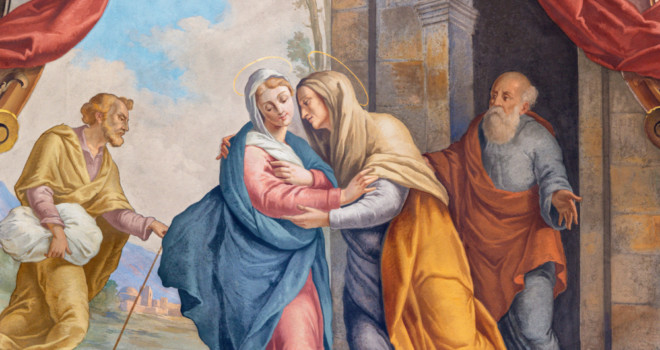Archbishop Sheen noted how the Cross cast its shadow backward over Our Blessed Lord’s entire life. I believe the same is true regarding the light of his Resurrection, and I would suggest that we see just such an instance in Jesus’ visitation to Mary and John (while within his mother’s womb). We find Jesus acting there, through the instrumentality of the Blessed Mother, the same way he will in his first post-Resurrection encounter with the apostles; and these mirrored events are instructive regarding the Church’s prayer and celebration of the sacraments.
Let us begin with Jesus visitation of the apostles:
“On the evening of that day, the first day of the week, the doors being shut where the disciples were, for fear of the Jews, Jesus came and stood among them and said to them, ‘Peace be with you.’ When he had said this, he showed them his hands and his side. Then the disciples were glad when they saw the Lord. Jesus said to them again, ‘Peace be with you. As the Father has sent me, even so I send you.” And when he had said this, he breathed on them, and said to them, ‘Receive the Holy Spirit…’” (Jn 20:19-22)
Note the significant elements: Jesus’ arrival with a greeting of “Peace” (the standard Jewish greeting “Shalom”) and the imparting of the Spirit.
Don’t we find the same elements in Luke’s account of the Visitation?
“[Mary] entered the house of Zechariah and greeted Elizabeth. And when Elizabeth heard the greeting of Mary, the babe leaped in her womb; and Elizabeth was filled with the Holy Spirit and she exclaimed with a loud cry, ‘Blessed are you among women, and blessed is the fruit of your womb! …Behold, when the voice of your greeting came to my ears, the babe in my womb leaped for joy.” (Lk 1:40-44)
There is of course a difference between the two events. In the visitation to Mary and John, Jesus’ bestowal of the Spirit was tied to his mother’s words. It was Christ acting for only he can impart the Spirit; but he did so from within Mary. It was as if Jesus granted a quasi-sacramental character to Mary’s greeting of “peace.” It points ahead to Jesus visit to the apostles and institution of the sacrament of reconciliation: “And when he had said this, he breathed on them, and said to them, ‘Receive the Holy Spirit. If you forgive the sins of any, they are forgiven; if you retain the sins of any, they are retained’” (Jn 20:22-23). There is a beautiful symmetry.
But there’s another element we shouldn’t miss – and that is the reaction of Elizabeth, John, and Mary to being “filled with the Holy Spirit,” and how it anticipates the apostles’ reaction at Pentecost. John, while still in utero, “leaped for joy” and Elizabeth “exclaimed” God’s redemptive work “with a loud cry”; and the Blessed Mother sang her Magnificat: “My soul magnifies the Lord,/ and my spirit rejoices in God my Savior,/ …for he who is mighty has done great things for me,/ and holy is his name./ And his mercy is on those who fear him/ from generation to generation./ He has shown strength with his arm,/…He has helped his servant Israel,/ in remembrance of his mercy,/ as he spoke to our fathers,/ to Abraham and to his posterity for ever” (Lk 1:46-51, 54-55).
We see the same reaction when the apostles and Mary were “filled” with the Spirit at Pentecost. They “began to speak in other tongues,” of “the mighty works of God…as the Spirit gave them utterance” (Acts 2:4,11). All of this is the action of the Spirit upon the human heart. As Christ is the source of the Spirit, so is he the author of the Church’s prayer. Recall Mary’s words, “my spirit rejoices in God my Savior” – that is Christ Jesus, present within her womb, pouring out the Holy Spirit. He inspired Mary to cry out in the Magnificat and he inspires us to cry out in the Our Father, “God has sent the Spirit of his Son into our hearts, crying, “Abba! Father!” (Gal 4:6).
The glory of the Resurrection and its life-changing affect upon the Church were already present in Jesus’ Marian visitation to Elizabeth and John.
✠













